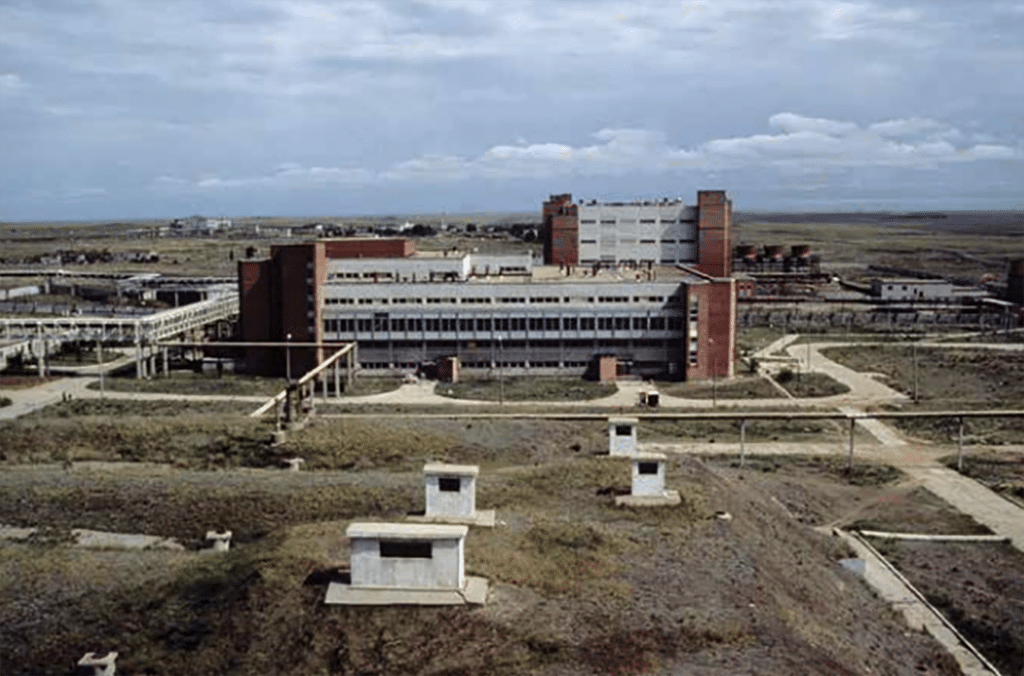How the Biological Weapons Convention could verify treaty compliance
By James Revill | March 5, 2024
 The former Stepnogorsk biological weapons complex in Kazakhstan. (US Department of Defense)
The former Stepnogorsk biological weapons complex in Kazakhstan. (US Department of Defense)
While significant chemical and nuclear weapons agreements contain verification provisions, the 1972 Biological Weapons Convention (BWC) does not. World governments have not discussed this topic within the treaty framework for two decades, after several years of work to develop a verification system failed in 2001.
Much has changed in science and security since then: Artificial intelligence (AI), genome editing, and other capabilities continue to accelerate and converge, resulting in ever more powerful technologies in the hands of a growing number of actors. In parallel, the international security environment has become more complex and competitive. Under these circumstances, it was remarkable that at the Ninth BWC Review Conference in late 2022, 185 countries agreed on a report with a forward-looking strategy to form a working group to discuss the long-standing issues of compliance and verification of the BWC, among several other matters.
Despite the challenging geostrategic context, the group engaged in a constructive dialogue over three days in December 2023, managing to move beyond the impasse around the failed verification protocol negotiations decades ago that stymied discussion on verification and compliance ever since. Moreover, the group recognized significant scientific and technological developments, including new open source verification opportunities and microbial forensic techniques that weren’t available in the late 1990s and early 2000s, but may be now. But there remains a gap between what is technically possible in terms of verifying that countries are in compliance with the treaty, and what BWC member states view as politically feasible and financially acceptable.
A path to verification? Before any new methods of treaty verification, whatever their merit, can be deployed, BWC members must overcome several hurdles to develop a verification system.
Conceptual clarity. During the December working group session, it was apparent that many countries were in the “early stages of conceptual thinking” about verification, with differing visions on the definition, objectives, and scope of any BWC verification mechanism. To progress, states will have to develop a shared understanding of the scope and purposes of BWC verification ahead of a working group meeting later this year.
Defining biological weapons. Several BWC member states also indicated the need for clarity around the definition of biological weapons. Article I of the convention includes an intent-based definition of biological weapons. This approach has future-proofed the prohibition on biological weapons against changes in science and technology. However, other treaties using a similar intent-based definition, such as the Chemical Weapons Convention, have supplemented this comprehensive approach with lists of chemicals and threshold quantities for the application of verification measures. Furthermore, the draft text under negotiation in the protocol process included a non-exhaustive list of agents that could be used in biological weapons.
Agreement around a list of agents for verification purposes—potentially building on earlier work during the protocol talks—may be possible. Moreover, such a list could help focus any verification mechanism, particularly if negotiators envisage some system of declarations and routine inspections. However, negotiating a list or lists of agents will take considerable time, and any list will remain vulnerable to gaps generated by new or novel agents excluded from it.
In terms of setting limits to the permitted amount of listed agents, methods of calculating threshold quantities have been studied and discussed in the past. However, developing threshold quantities is likely to be difficult and of limited value in building confidence in compliance with the BWC because, as discussed during the protocol negotiations, “the self-replicating nature of microorganisms means that an agent amount at or below a threshold could be exceeded within a matter of hours.”
Verification methods. As illustrated in presentations by the International Atomic Energy Agency (IAEA) and Organization for the Prohibition of Chemical Weapons (OPCW) during the December working group meeting, routine industry inspections are possible as part of a disarmament verification system. The IAEA conducted 2975 verification missions in 2022, and before the pandemic, the OPCW undertook 241 facility inspections a year. A number of countries, including the Russian Federation and China, indicated support for some sort of routine on-site industry inspections, which are often seen as a core component of traditional disarmament verification regimes.
But others, including the United States, have expressed doubts over the value of routine on-site inspections in the BWC context. This is in part because of the sheer number of life science research facilities operating around the world; in 2022 alone some 17,000 institutions around the world published papers on the topic of “biology” (broadly understood), and more than 15,000 unique applicants submitted biotechnology-related patents. Also, some observers note the difficulties in reliably assessing compliance in a diverse range of dual-use facilities around the globe and the limitations of material accounting-type verification methodologies—as applied in other weapons of mass destruction treaties—in the biological weapons context.
Some form of routine inspection system may be technically possible. But this area will require considerable additional work to determine the extent to which routine inspections can build greater confidence in compliance, and, if so, how much BWC members are really willing to pay for such a system.
Resources. The BWC budget for 2023 was $2.1 million (€1.9 million). This covers the costs of BWC meetings and a four-person Implementation Support Unit, which works on the implementation and universalization of the BWC, as well as organizing and staffing BWC meetings and administering confidence building measures. If governments are serious about developing a verification regime, considerable additional resources will be required. For example, in 2022 the OPCW spent more than $32 million (€30.3 million) on verification and inspections, and the IAEA allocated more than $166 million (€153.7 million) to nuclear verification.
Expectations for the BWC working group. In addition to political challenges, the working group is also up against very real practical limitations. It has only seven days through the end of 2025 booked for discussion on compliance and verification. This is insufficient on its own to generate a blueprint for biological verification that is “politically palatable, technologically feasible and financially viable and sustainable.” However, this doesn’t preclude the working group developing what its chair, Brazilian Ambassador Flávio Soares Damico, has termed a “roadmap” for strengthening the BWC.
In developing such a roadmap, BWC member states may want to explore additional parallel tracks of activity to lock in work on verification and generate new insights to inform and advance the ongoing discussion of the working group.
One obvious track could involve the establishment of a group to further consider the scientific and technical aspects of verification and how they have changed since 2001. The BWC established a group of verification experts (VEREX) in 1991 to explore verification measures. This group met on four occasions in the early 1990s, generating findings that informed the protocol negotiations in the following years. A new group could be mandated to identify and evaluate biological verification technologies (both old and new), effectively initiating a form of VEREX 2.0.
Trial inspections to determine the efficacy of on-site inspections were important in developing the verification mechanism for the Chemical Weapons Convention. Such exploratory exercises could be undertaken transparently through a geographically representative “collective of the interested,” with the findings subsequently feeding into the working group. Such experiences could help in assessing the benefits and limitations of routine on-site or challenge inspections.
Segments of the pharmaceutical industry were critical of the 2001 protocol efforts and expressed concern over the impacts of an intrusive verification system. A constructive industry relationship—along the lines of the partnership forged between the OPCW and the chemical industry—will be important to achieving any sustainable BWC verification regime. Such a relationship needs to be carefully nurtured to avoid alienating or alarming a trillion-dollar global industry.
Such external initiatives should augment, not distract or detract, from the activities of the working group itself, which will also need sustained attention to stimulate thinking around verification and other agenda items, including international cooperation, science and technology review mechanisms, confidence building measures, transparency, and national implementation.
It will also be important over the course of the working group process to manage expectations. No politically palatable, technologically feasible, and financially sustainable system is going to be able to guarantee the detection of any form of biological weapon. However, there are measures that in combination could generate considerably greater confidence in compliance by BWC states parties and provide a route to robust investigation of credible allegations of non-compliance. In this sense, the challenge for the working group is not to develop a roadmap to a perfect system, but to chart a route towards a system in which the security benefits of being on the inside are greater than the overall benefits of remaining on the outside. Even an imperfect multilateral verification mechanism would provide a valuable defense against a class of weapons rightly deemed “repugnant to the conscience of [hu]mankind.”
Together, we make the world safer.
The Bulletin elevates expert voices above the noise. But as an independent nonprofit organization, our operations depend on the support of readers like you. Help us continue to deliver quality journalism that holds leaders accountable. Your support of our work at any level is important. In return, we promise our coverage will be understandable, influential, vigilant, solution-oriented, and fair-minded. Together we can make a difference.
Keywords: BWC, treaty verification
Topics: Biosecurity















